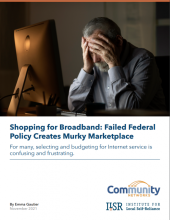[Updated Report] Shopping for Broadband: Failed Federal Policy Creates Murky Marketplace
In November, the Institute for Local Self-Reliance published a report examining the transparency practices of Internet Service Providers (ISPs). Shopping for Broadband: Failed Federal Policy Creates Murky Marketplace [pdf] identified locally-controlled broadband networks as the most transparent around key service details.
Large ISPs, however, were found to be more likely to make information like upload speed and pricing difficult or impossible for potential customers to find.
After the report’s original publication, a WISP advocate suggested that our fixed wireless sample may not appropriately represent the industry and requested that we review and re-issue our analysis with an alternative list of ISPs that have been more aggressive in pursuing federal funding and spectrum opportunities. These WISPs greatly outperformed our original sample, which was selected based on those claiming the largest population coverage.
New Set of WISPs Shows Better Transparency
While many of the original WISPs failed to disclose basic pricing and service information, only two of the second set offered less than excellent information in all categories. The second set had less poor quality information and slightly more missing information than our set of cooperatively-run networks. Municipal networks remained the most transparent.
Though many of the fixed wireless providers originally studied do seem to claim the greatest number of potential customers, we agree with some reviewers that they are not actually among the largest fixed wireless ISPs with the most subscribers. The new list of WISPs, which is included alongside the original one on the Broadband Transparency Rule Compliance Scorecard, may be a more accurate representation of providers’ transparency practices in this industry.



